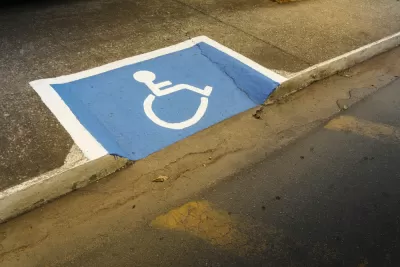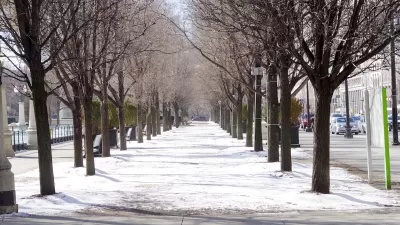Despite the passage of the Americans with Disabilities Act more than 30 years ago, most U.S. cities delay making accessibility improvements to sidewalks until activists bring them to court.

Streetsblog’s Kea Wilson examines why sidewalk accessibility in U.S. cities so often depends on lawsuits filed by mobility advocates despite the existence of the Americans with Disabilities Act (ADA), which ostensibly mandates compliance with accessibility requirements.
As Wilson explains, “Cities like Baltimore, Long Beach, Calif. and Portland, Ore. have all been sued for dangerous sidewalk conditions, but even the suits that advocates win can take decades to translate into real roadway results.”
Of course, funding accessible, complete, and well-maintained networks of sidewalks as the basic civil right they should have always been — and doing it before the lawyers get involved — would make a far greater difference for people with mobility challenges than any lawsuits.
But according to attorney Meredith Weaver, “there are structural reasons why city sidewalk policy can seem so callous — and they help explain why it often takes a multi-year lawsuit to get them to act.” One reason is money, Weaver points out. “I think, given an endless supply of cash, most of them would probably be doing this work already. But without resources, things can fall by the wayside.” Cities end up holding out as long as possible before repairing sidewalks, which would benefit not only people with disabilities but also elderly people, parents with strollers, and anyone with temporary or permanent mobility challenges.
FULL STORY: Why Do People With Disabilities Have to Sue To Get Accessible Sidewalks?

Study: Maui’s Plan to Convert Vacation Rentals to Long-Term Housing Could Cause Nearly $1 Billion Economic Loss
The plan would reduce visitor accommodation by 25,% resulting in 1,900 jobs lost.

North Texas Transit Leaders Tout Benefits of TOD for Growing Region
At a summit focused on transit-oriented development, policymakers discussed how North Texas’ expanded light rail system can serve as a tool for economic growth.

Using Old Oil and Gas Wells for Green Energy Storage
Penn State researchers have found that repurposing abandoned oil and gas wells for geothermal-assisted compressed-air energy storage can boost efficiency, reduce environmental risks, and support clean energy and job transitions.

Santa Barbara Could Build Housing on County Land
County supervisors moved forward a proposal to build workforce housing on two county-owned parcels.

San Mateo Formally Opposes Freeway Project
The city council will send a letter to Caltrans urging the agency to reconsider a plan to expand the 101 through the city of San Mateo.

A Bronx Community Fights to Have its Voice Heard
After organizing and giving input for decades, the community around the Kingsbridge Armory might actually see it redeveloped — and they want to continue to have a say in how it goes.
Urban Design for Planners 1: Software Tools
This six-course series explores essential urban design concepts using open source software and equips planners with the tools they need to participate fully in the urban design process.
Planning for Universal Design
Learn the tools for implementing Universal Design in planning regulations.
Ascent Environmental
Borough of Carlisle
Institute for Housing and Urban Development Studies (IHS)
City of Grandview
Harvard GSD Executive Education
Toledo-Lucas County Plan Commissions
Salt Lake City
NYU Wagner Graduate School of Public Service





























